

National Flag of Trinidad and Tobago


Trinidad, lies at the southern end of the Caribbean chain. Trinidad is half forested; its steep and dramatic north coast is guarded by the mountains of the Northern Range, rising to 3,085 feet. The middle of the island is a lovely windswept plain where cane sugar is grown, giving way to low rolling hills in the south. There are some fine beaches along the north coast, and miles of beach along the east coast, cooled by the Atlantic breezes. It is a lively cosmopolitan island full of action, music, festivals and vitality. It is the home of Caribbean Carnival, and the place where steelband, calypso and limbo were created; with a population continually mixed for over two centuries, it also celebrates a wide range of other big festivals, both cultural and religious. Naturalists too, especially birdwatchers, are attracted by its huge variety of flora and fauna.
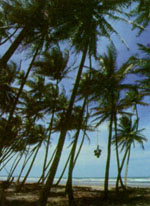

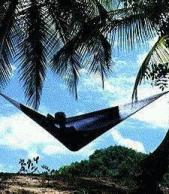
 Trinidad is also a paradise for nature-lovers. With well over 400 species of birds and over 600 different butterflies, 2,300 species of flowering plants, extensive rain forest, rare animals and internationally famous nature centres, Trinidad is rightly known as a leading eco-tourism centre.
Trinidad is also a paradise for nature-lovers. With well over 400 species of birds and over 600 different butterflies, 2,300 species of flowering plants, extensive rain forest, rare animals and internationally famous nature centres, Trinidad is rightly known as a leading eco-tourism centre.
Among the major sites are the Caroni Bird Sanctuary near Port of Spain, where spectacular flocks of Scarlet Ibis swoop down at sunset to roost; the Asa Wright Nature Centre in the Northern Range, an internationally famous centre for birders and naturalists; and the Pointea-Pierre Wild Fowl Trust near San Fernando, where many wildfowl species have been lovingly
protected for return to the wild. 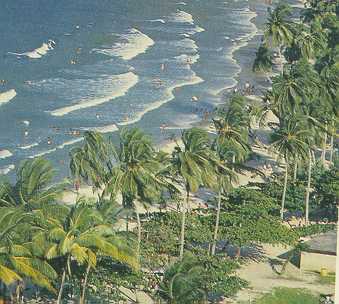 At Matura on the east coast, and at several places on the north coast, giant sea turtles lumber onto the beach every year to lay their eggs in the sand.
At Matura on the east coast, and at several places on the north coast, giant sea turtles lumber onto the beach every year to lay their eggs in the sand.
But Trinidad has developed fast in recent years; traditionally an agricultural island, it has become the region's most industrialised economy Port of Spain is a cosmopolitan city teeming with activity - steelband music, chutney, calypso and soca (Trinidad must have more musicians and performers per square mile than any other place on earth), theatre and painting, fashion design, parties and festivals. With its open Savannah, the non-stop action of St James and the new Brian Lara Promenade downtown, this is one of the liveliest places to spend a holiday.

This is a link to recipes and food related subjects of Trinidad and Tobago
This is a link with both our food and dialect

While its sister Tobago offers quiet beauty and relaxation, Trinidad generates excitement and entertainment. The annual Carnival (Trinidadians proudly insist it's the greatest show on earth) is an awesome spectacle. After a warming up period of several weeks, it explodes on the Monday and Tuesday before Lent in a peaceful, colourful riot of street dancing and partying.
The 200-year-old Carnival - which has now spread to more than 100 cities and countries around the world - produced the unique music of calypso, which created in turn a modern offshoot with a faster beat, soca; and the steel pan, a unique instrument originally forged from discarded oildrums.
Every Carnival season, perhaps 100 steel orchestras, the bigger ones with over 100 players wind revellers into a frenzy of excitement.
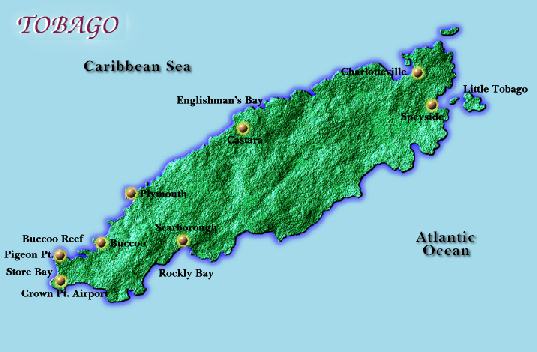
Tobago is a lovely, unspoiled holiday island, with a warm and peaceful lifestyle that reminds its visitors of the way the Caribbean used to be. It offers all the traditional beauties of a tropical holiday - warm sun, white sandy beaches and clear blue water, cascading waterfalls,tranquillity, relaxation. It also offers outstanding diving (the giant and gentle manta rays off Speyside have attracted thousands of scuba enthusiasts), miles
of coral reefs, championship golf, and a rich Heritage Festival each summer, celebrating the island's folkways. Many of the comfortable and luxurious beachfront hotels are on the southwest coast, near Crown Point airport where your BWIA flight arrives. There is also a wide range of medium-price hotels and apartment complexes in that area, together with attractive small guest-houses and a well-organised bed and-breakfast programme, allowing visitors to stay in private homes. Visitor accommodation is well distributed, so you are never far from a comfortable base (or from the sea): outside the main hotel area in the south-west, there is good accommodation at Belle Garden, Speyside and Charlotteville. Tobago has a central range of hills rising to 1,860 feet, with a flatter area in the south where most of the hotels and restaurants are. You can have a very comfortable and memorable beach holiday in Tobago without stirring far from the hotel restaurant and bar or the water's inviting edge - most hotels have their own sports facilities and evening entertainment. But Tobago is one of the easiest islands to explore. Beyond the beaches and the sports, Tobago's main attractions are environmental. Its Main Ridge was the first protected reserve area in the western hemisphere (1764), and more than 230 years later it is still a rich area for birds and wildlife. The offshore coral reefs are among the finest in the world, and Little Tobago Island and the St Giles Islands, a short way offshore, are among the Caribbean's most important seabird sanctuaries. Pigeon Point beach is one of the most-photographed spots in the whole Caribbean; nearby Buccoo Reef is easily accessible even for non-divers, snorkelling in the shallow water or watching from glass-bottomed boats. Fort King George, the main
fortification from colonial days, perches on its hilltop above the capital Scarborough with unparalleled views of the island and the windflecked Atlantic: the adjoining museum is full of useful material for the historian. There's good tennis and golf (at the Mount Irvine golf course you can play 18 championship holes under the shade of the palms), and a full range of watersports, as
well as some excellent restaurants. Tobago hosts a major Caribbean regatta each May, and a popular game fishing tournament.
Tobago has a central range of hills rising to 1,860 feet, with a flatter area in the south where most of the hotels and restaurants are. You can have a very comfortable and memorable beach holiday in Tobago without stirring far from the hotel restaurant and bar or the water's inviting edge - most hotels have their own sports facilities and evening entertainment. But Tobago is one of the easiest islands to explore. Beyond the beaches and the sports, Tobago's main attractions are environmental. Its Main Ridge was the first protected reserve area in the western hemisphere (1764), and more than 230 years later it is still a rich area for birds and wildlife. The offshore coral reefs are among the finest in the world, and Little Tobago Island and the St Giles Islands, a short way offshore, are among the Caribbean's most important seabird sanctuaries. Pigeon Point beach is one of the most-photographed spots in the whole Caribbean; nearby Buccoo Reef is easily accessible even for non-divers, snorkelling in the shallow water or watching from glass-bottomed boats. Fort King George, the main
fortification from colonial days, perches on its hilltop above the capital Scarborough with unparalleled views of the island and the windflecked Atlantic: the adjoining museum is full of useful material for the historian. There's good tennis and golf (at the Mount Irvine golf course you can play 18 championship holes under the shade of the palms), and a full range of watersports, as
well as some excellent restaurants. Tobago hosts a major Caribbean regatta each May, and a popular game fishing tournament. 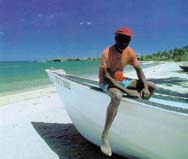 For much of the colonial period, Tobago was fought over by the Dutch, French and Spanish, pirates and even settlers from Latvia, until it became British in 1814. For many years it was the most prosperous sugar island in the Caribbean. Today, the great majority of Tobagonians are of African descent.
The island was joined to Trinidad as a single country at the end of the 19th century, after the collapse of its sugar market; together, the sister islands gained independence from Britain in 1962, and became a republic in 1976. Tobago now has its own House of Assembly; its population is about 45,000. Driving round the island need not take more than a day, at a leisurely pace. The eastern (Windward) coast road passes through a series of quiet
fishing villages, with stops at an old plantation house, the three-tiered Argyle Falls, Speyside (a good base for exploring the outstanding diving around the north-west coast) and Charlotteville in the north, set beside the magnificent harbour of Man o' War Bay. A road winds across the central hills to the even quieter west coast and some of the loveliest bays and
beaches in the whole Caribbean, largely unpopulated.
For much of the colonial period, Tobago was fought over by the Dutch, French and Spanish, pirates and even settlers from Latvia, until it became British in 1814. For many years it was the most prosperous sugar island in the Caribbean. Today, the great majority of Tobagonians are of African descent.
The island was joined to Trinidad as a single country at the end of the 19th century, after the collapse of its sugar market; together, the sister islands gained independence from Britain in 1962, and became a republic in 1976. Tobago now has its own House of Assembly; its population is about 45,000. Driving round the island need not take more than a day, at a leisurely pace. The eastern (Windward) coast road passes through a series of quiet
fishing villages, with stops at an old plantation house, the three-tiered Argyle Falls, Speyside (a good base for exploring the outstanding diving around the north-west coast) and Charlotteville in the north, set beside the magnificent harbour of Man o' War Bay. A road winds across the central hills to the even quieter west coast and some of the loveliest bays and
beaches in the whole Caribbean, largely unpopulated.

Call BWIA or your travel agent, and start packing. BWIA has direct flights into the Caribbean from New York, Miami, Toronto, London and Frankfurt.

A link to two of my country's leading news papers.
![]()
You are number

to visit this page


